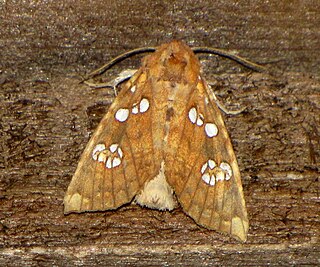
Acronicta is a genus of noctuid moths containing about 150 species distributed mainly in the temperate Holarctic, with some in adjacent subtropical regions. Caterpillars of most Acronicta species are unmistakable, with brightly colored hairy spikes, and often feed quite visibly on common foliate trees. The hairy spikes may contain poison, which cause itchy, painful, swollen rash in humans on contact. The larva of the smeared dagger moth is unusually hairy even for this genus. Acronicta species are generally known as dagger moths, as most have one or more black dagger-shaped markings on their forewing uppersides. But some species have a conspicuous dark ring marking instead.

Amyna is a genus of moths of the family Noctuidae erected by Achille Guenée in 1852.

Calesia is a genus of moths of the family Erebidae. The genus was erected by Achille Guenée in 1852.

Condica is a genus of moths of the family Noctuidae.

Isogona is a genus of moths of the family Erebidae. The genus was erected by Achille Guenée in 1852.
Diastema is a genus of moths of the family Noctuidae. The genus was erected by Achille Guenée in 1852.
Dyomyx is a genus of moths of the family Erebidae. The genus was erected by Achille Guenée in 1852.
Eumestleta is a genus of moths of the family Erebidae. The genus was erected by Arthur Gardiner Butler in 1892.

Lesmone is a genus of moths in the family Erebidae. The genus was erected by Jacob Hübner in 1818.
Leuconycta is a genus of moths of the family Noctuidae. The genus was first described by George Hampson in 1909.

Paectes is a genus of moths of the family Euteliidae erected by Jacob Hübner in 1818.

Pandesma is a genus of moths in the family Erebidae. The genus was erected by Achille Guenée in 1852.

Papaipema is a genus of moths of the family Noctuidae. The genus was erected by John B. Smith in 1899.
Phyllophila is a genus of moths of the family Noctuidae. The genus was erected by Achille Guenée in 1852.

Ponometia is a genus of moths of the family Noctuidae. The genus was erected by Gottlieb August Wilhelm Herrich-Schäffer in 1868.

Ptichodis is a genus of moths in the family Erebidae. The genus was erected by Jacob Hübner in 1818.

Spragueia is a genus of moths of the family Noctuidae. The genus was erected by Augustus Radcliffe Grote in 1875. Some authors include it in Acontia, but it is tentatively treated as different here pending further research.
Thyriodes is a genus of moths of the family Euteliidae. The genus was erected by Achille Guenée in 1852.

Nemoria is a genus of emerald moths in the family Geometridae. It was named by Jacob Hübner in 1818.
Xanthodes is a genus of moths of the family Nolidae. The genus was erected by Achille Guenée in 1852.











